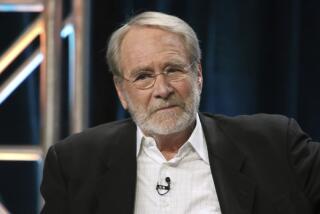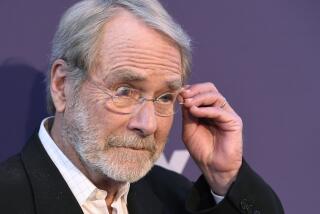A fresh heir in the Muir wilderness
- Share via
LEE VINING, CALIF. — Gale-force winds were whipping whitecaps and spray across Mono Lake when Robert Hanna spotted a distant hiker.
It was a crummy day to chat up a stranger in a state park, but Hanna was upbeat, as usual.
He stepped hurriedly along a trail to introduce himself. “Hello there!” Hanna said, flashing a toothy smile. “Do you know that California wants to shut this place down? Would you like to sign our petition to keep it open?”
“Yeah, I guess so,” the man said.
“Wow! That’s great,” Hanna said, reaching to shake his hand. “Every signature counts.”
The hiker signed and traipsed off, not realizing he’d just shaken hands with the great-great-grandson of John Muir.
Less than a year ago, Hanna was leading a fairly ordinary life as a corporate manager with a wife and two children. Not even his closest friends knew of his relationship with the man who founded the Sierra Club and helped establish Yosemite and Sequoia national parks.
Then, in May, Hanna was laid off as a sales director for Securities National Finance Corp.
He took stock of his options, obligations and dreams.
John Muir had always loomed as an obligation. But what part the 19th century explorer of the Sierra Nevada was to play in Hanna’s dreams was less clear. Hanna had always felt both part of the Muir legacy and apart from it.
“I always kept my lineage to myself because of an unspoken family code: Use John Muir’s name sparingly and only with respect,” Hanna said.
--
Growing up, Hanna attended family reunions at the mansion in Martinez, Calif., where Muir lived, farmed and wrote the rhapsodic tales of his wilderness sojourns that catalyzed the conservation movement. Stories of his life and times tumbled nonstop from family elders. Most summers, Hanna spent time at a 90-year-old family cabin near Mono Lake and played hide-and-seek among the tufa formations in the park he is now trying to save.
Then there were all those places on the map of California that bore his great-great-grandfather’s name: Muir Rock in Kings Canyon National Park, Muir Peak in Los Angeles County, Muir Woods National Monument in Marin County.
In school, his great-great-grandfather was part of history lessons. Still, he kept quiet, his heritage obscured by a surname that came from the marriage of Muir’s eldest daughter, Wanda, to Tom Hanna.
He kept mum at his first job, behind the counter of a sporting goods store, and at Sierra College in Rocklin, east of Sacramento, where he took a course called “John Muir’s Range of Light.”
“Robert took an unusually strong interest in the subject matter but never let on that he was related to John Muir,” recalled history instructor Gary Noy, who still teaches the course. “Over time, I came to believe he has Muir’s fire in his belly.”
Even Hanna’s wife, Lavina, didn’t know of his tie to Muir until 2005, a decade after they met.
By 2007, Hanna was getting restless. On the first anniversary of their wedding, he made an announcement: “I’m not happy at the company; it’s empty,” he told his wife. “I’ve got this idea for a small business that would enable me to make a living while spending a lot more time in wild places.”
Hanna would call it Range of Light -- Muir’s phrase for the High Sierra -- and it would sell outdoor clothing emblazoned with previously unpublished quotes from Muir’s letters and notes.
Because of the demands of his job, Range of Light existed only on paper for four years. “Then I was laid off,” he said. “A few days after that, the state announced plans to close down dozens of parks. It was time to take a leap of faith.”
Hanna decided to make Range of Light a reality and start a new life as an environmental activist.
“I’ll never be another John Muir,” said Hanna, 31, who shares a home in the Sacramento suburb of Roseville with his wife and their daughters Sierra, 2 1/2 , and Sophia, 7 months. “But I’ve got his passion and values coursing through my veins.”
These days, Hanna is a man in motion; a popular speaker at grass-roots rallies and protests; a tour guide at environmental hot spots; a board member of nonprofits, including the John Muir Assn.
As for his apparel business, launched late last year, some might think it heretical to take commercial advantage of the Muir name.
But Hanna is unapologetic. Muir, he points out, was a friend of powerful industrialists and politicians and a savvy California fruit grower who left an estate worth $5 million when he died in 1914.
Hanna pitched his idea to family elders in June. Their enthusiastic approval was a pleasant surprise.
A few days later, he visited Muir’s grave in a family plot in Martinez. “I raked up the leaves and brushed the dust off the headstones,” he recalled. “Then I sat down and spoke to Muir. I said, ‘I hope what I’m doing is all right with you.’ ”
--
Range of Light has big ambitions and one employee: Hanna. It sells windbreakers, T-shirts, vests, beanies and water bottles online. Hanna has agreements to begin selling his products at tourist centers throughout the Sierra range, including at Lake Tahoe, Mono Lake and Yosemite National Park, beginning in March and April.
The Muir-Hanna clan has long resisted invitations to take public stands on environmental issues that were important to Muir, such as a proposal to restore Hetch Hetchy Valley in Yosemite National Park to its former splendor. Muir tried but failed to prevent San Francisco from winning congressional approval in 1913 to build O’Shaughnessy Dam, which buried the valley under 300 feet of water.
But the family welcomes Hanna’s efforts to draw attention to Hetch Hetchy and his use of the Muir-Hanna Trust’s copyright archives, housed at the College of the Pacific in Stockton. There are plenty of “Muirisms” for Hanna’s Range of Light to choose from at the college’s Center for John Muir Environmental Studies, where Muir’s letters and notebooks take up more than 50 feet of bookshelves.
Range of Light selected this one for a line of cotton T-shirts: “Keep up the good fight. Victory in this case will go far to save all our noble Godful parks.”
Hanna’s spirit impresses Ross Hanna, 89, Muir’s last living grandson and Hanna’s great-uncle. “Muir was quite a guy, involved in all kinds of things, and he didn’t give a damn what people thought of him,” he said. “Robert is the same way.”
Like many of his relatives, Robert Hanna draws inspiration from cherished artifacts. One of his uncles has Muir’s mahogany bed. Other relatives have Muir’s sideboard, Muir’s wife’s piano and Muir’s daughters’ violins. Several own Muir-commissioned oil paintings of landscapes by artist William Keith.
“I have these little things,” Hanna said, holding up two small glass inkwells Muir used in writing the Sierra Club’s founding documents. “Late at night, when I’m tired and frustrated, I look at these bottles, out of which flowed words that changed the world. Then I get back to work knowing that, yes, I can write one more letter, make one more phone call, snag one more signature on a petition.”
Hanna took a swipe at the Sierra Club, which he believes went astray under the leadership of Carl Pope, who stepped down as chairman in November. Of particular concern, he said, was the organization’s shift away from grass-roots campaigns and toward efforts to combat global warming and forge alliances with international corporations.
“Muir would have tossed Carl Pope off Yosemite’s Half Dome,” Hanna said, referring to the Sierra Club’s decision in 2007 to let Clorox Co. use its logo on a line of “green” products in return for $1.3 million.
Pope was unavailable for comment. However, in an earlier interview, he said that critics of the Clorox decision missed the point. “We’re not going to save the world if we rely only on those who agree with the Sierra Club,” he said. “There aren’t enough of them. My aim is getting it right for the long term.”
--
Grass-roots activists welcome Hanna’s concern for local issues, and the cachet of having “the great-great-grandson of John Muir” on their side.
“This guy is a mountain of energy, and failure is not an option for him,” said Robert Berman, a spokesman for a Bay Area advocacy group, Protect Benicia State Parks. “He’s committed to helping us make connections with the legislative community and funding organizations, and get more press and visibility.”
Geoff McQuilkin, executive director of the 16,000-member Mono Lake Committee, a nonprofit organized in 1978 to protect the region’s bowl-shaped high country ecosystem, agreed.
“We’ve already got a lot of experts and scientists,” McQuilkin said. “But Robert’s infectious enthusiasm is what the environmental movement needs more of. I regard him as a friend and colleague who has been critical in the battle to keep Mono Lake open.”
In December, the state Department of Parks announced that Mono Lake had been taken off the state park closure list. Under an agreement with the state, the nonprofit Bodie Foundation will collect parking fees of about $3 per vehicle at a popular viewpoint on the west side of the lake to help pay the park’s operating expenses.
“That leaves 66 state parks that still need all the help they can get,” Hanna said.
--
More to Read
Sign up for Essential California
The most important California stories and recommendations in your inbox every morning.
You may occasionally receive promotional content from the Los Angeles Times.










